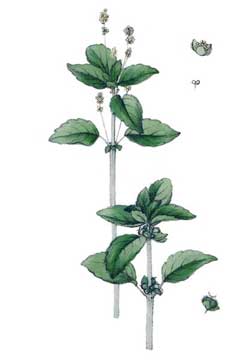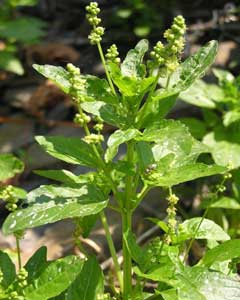 |
|
http://commons.wikimedia.org/wiki/File:Mercurialis_annua_L_ag1.jpg |
 |
| http://commons.wikimedia.org/wiki/User:Mbc |
Translate this page:
Summary
Physical Characteristics

 Mercurialis annua is a ANNUAL growing to 0.5 m (1ft 8in).
Mercurialis annua is a ANNUAL growing to 0.5 m (1ft 8in).
It is not frost tender. It is in flower from July to October. The species is dioecious (individual flowers are either male or female, but only one sex is to be found on any one plant so both male and female plants must be grown if seed is required). and is pollinated by Bees, flies, wind. The plant is not self-fertile.
Suitable for: light (sandy), medium (loamy) and heavy (clay) soils. Suitable pH: mildly acid, neutral and basic (mildly alkaline) soils. It cannot grow in the shade. It prefers moist soil.
UK Hardiness Map
US Hardiness Map
Synonyms
Plant Habitats
Hedgerow;
Edible Uses
Edible Parts: Leaves Oil
Edible Uses: Oil
Leaves - cooked[2, 4, 66, 105]. They were at one time quite popular, being used like spinach[4]. The acrid principle is said to be destroyed by thoroughly boiling the leaves[4]. The raw leaves are poisonous[66]. It is probably wise not to eat the leaves of this plant[9].
References More on Edible Uses
Medicinal Uses
Plants For A Future can not take any responsibility for any adverse effects from the use of plants. Always seek advice from a professional before using a plant medicinally.
Emetic Emollient Homeopathy Ophthalmic Purgative Warts Women's complaints
The whole plant, and especially the juice, is emetic, emollient and purgative. It is used externally to treat women's complaints, ear and eye problems, warts and sores[4, 9]. A homeopathic remedy is made from the plant[9]. It is used in the treatment of rheumatism, dropsy, diarrhoea and disorders of the gall bladder and liver[9].
References More on Medicinal Uses
The Bookshop: Edible Plant Books
Our Latest books on Perennial Plants For Food Forests and Permaculture Gardens in paperback or digital formats.

Edible Tropical Plants
Food Forest Plants for Hotter Conditions: 250+ Plants For Tropical Food Forests & Permaculture Gardens.
More

Edible Temperate Plants
Plants for Your Food Forest: 500 Plants for Temperate Food Forests & Permaculture Gardens.
More

More Books
PFAF have eight books available in paperback and digital formats. Browse the shop for more information.
Shop Now
Other Uses
Oil
This species is a potential source of a very good drying oil[61].
Special Uses
References More on Other Uses
Cultivation details
A common garden weed in Britain, it should need little encouragement. When well suited, it tends to spread itself around too freely for most people's tastes[4]. It dislikes growing in shady positions. Plants are normally dioecious, though monoecious plants are sometimes found[4]. Male and female plants must normally be grown if seed is required.
References Carbon Farming Information and Carbon Sequestration Information
Temperature Converter
Type a value in the Celsius field to convert the value to Fahrenheit:
Fahrenheit:
The PFAF Bookshop
Plants For A Future have a number of books available in paperback and digital form. Book titles include Edible Plants, Edible Perennials, Edible Trees,Edible Shrubs, Woodland Gardening, and Temperate Food Forest Plants. Our new book is Food Forest Plants For Hotter Conditions (Tropical and Sub-Tropical).
Shop Now
Plant Propagation
Seed - sow spring or autumn in situ.
Other Names
If available other names are mentioned here
Native Range
TEMPERATE ASIA: Cyprus, Egypt (Sinai), Iraq, Israel, Jordan, Lebanon, Syria, Turkey, Georgia EUROPE: Austria, Belgium, Switzerland, Germany, Hungary, Netherlands, Poland, Russian Federation (European part), Ukraine (incl. Krym), Former Yugoslavia, Albania, Bulgaria, Greece (incl. Crete), Italy (incl. Sardinia, Sicily), Romania, Spain (incl. Baleares), France (incl. Corsica), Portugal AFRICA: Spain (Canarias), Portugal (Madeira Islands), Algeria, Egypt, Libya, Morocco, Tunisia
Weed Potential
Right plant wrong place. We are currently updating this section.
Please note that a plant may be invasive in one area but may not in your area so it's worth checking.
Conservation Status
IUCN Red List of Threatened Plants Status :

Growth: S = slow M = medium F = fast. Soil: L = light (sandy) M = medium H = heavy (clay). pH: A = acid N = neutral B = basic (alkaline). Shade: F = full shade S = semi-shade N = no shade. Moisture: D = dry M = Moist We = wet Wa = water.
Now available:
Food Forest Plants for Mediterranean Conditions
350+ Perennial Plants For Mediterranean and Drier Food Forests and Permaculture Gardens.
[Paperback and eBook]
This is the third in Plants For A Future's series of plant guides for food forests tailored to
specific climate zones. Following volumes on temperate and tropical ecosystems, this book focuses
on species suited to Mediterranean conditions—regions with hot, dry summers and cool, wet winters,
often facing the added challenge of climate change.
Read More
Expert comment
Author
L.
Botanical References
17
Links / References
For a list of references used on this page please go here
Readers comment
© 2010, Plants For A Future. Plants For A Future is a charitable company limited by guarantee, registered in England and Wales. Charity No. 1057719, Company No. 3204567.